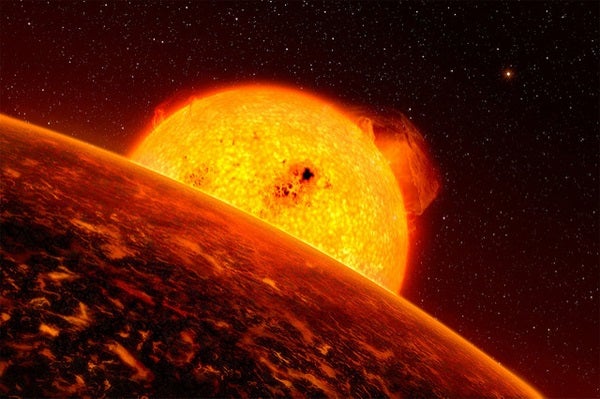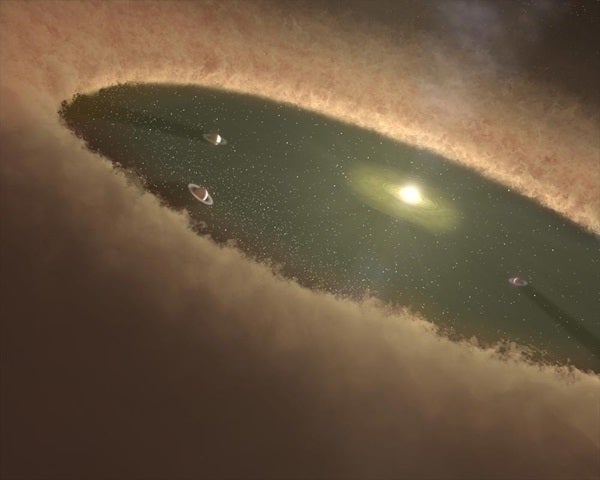“There could be several different origins for Earth-like masses,” says Arieh Konigl, a theorist at the University of Chicago. Konigl and his fellow scientists study hot Earths in search of how they may have formed. They found that the new class of exoplanets, born of hot Jupiters, could take two distinct paths as a gas giant moves dangerously close to its star.
Early and late
Konigl and his colleagues were intrigued by a paper last year that announced a new population of hot Earths, rocky worlds that orbited their sun in only a handful of days. The authors suggested that these planets could be the cores of hot Jupiters. Intrigued, Konigl’s team began to model what happened when hot Jupiters lost their atmospheres.
In our solar system, the gas giants all lie far from the Sun, in stable orbits in the cooler region beyond the asteroid belt. Both gas giants and rocky worlds were built from the bottom up as dust and rock were pulled together by gravity. While gases such as hydrogen and helium were burned off by the Sun in the inner solar system, the outer solar system stayed cool, and the gases piled onto planets like Jupiter and Saturn. Eventually, these worlds settled into stable orbits not far from where they were born.
But not all planets stay put. When planets interact with one another gravitationally, they can be thrown inward toward their star, where gravity and high temperatures can strip a massive world of its atmosphere and leave behind only a rocky core.
Early cores zipped in from the outskirts of their system. Their wildly eccentric orbits allowed them to slip inside the Roche limit. Once inside, gravity ripped the gas from the world, leaving behind a core of rock and circularizing their orbit. The same process that stole their gas also moved them back outside the Roche limit, leaving them with longer orbits of a few days.
Late cores took a calmer approach, spiraling slowly in toward their star. At the Roche limit, they began to lose their atmosphere and continued to drift inward, ultimately taking only a single day to whip around their sun.
“We found this distribution straddling one day,” Konigl says. “Everything fell into place.”
Not so fast
In 1995, astronomers discovered the first world orbiting a Sun-like star: a massive gas giant with an orbit of about four days. A wealth of planets followed, all built like the first and all shockingly unlike our solar system.
The massive, close-in planets continued to dominate the exoplanet population (simply because they are easiest to detect via the earliest methods) until NASA launched its Kepler spacecraft in 2009, releasing the first of its observations in 2010. Suddenly, smaller worlds swam into view, among them hot Earths.
Hot Earths are strikingly similar to hot Jupiters when it comes to numbers. Both types of worlds make up about half a percent of Kepler objects of interest, suggesting they could be related. “That already indicated a connection,” Konigl says.
Hot Earths aren’t the only rocky worlds discovered. A collection known as ultra-short-period planets (USPs) also have orbits of less than a day. Originally, scientists thought USPs could be the cores of hot Jupiters, but further modeling revealed that these worlds could not have formed from gas giants.
In tossing out hot Jupiters as the origin of USPs, however, all hot Earths were initially dismissed. Part of that came from the destructive nature of the Roche limit. If a hot Jupiter spends too much time within the Roche limit, it would be ripped apart.
Hot Jupiters seem to support this idea. According to Konigl, no hot Jupiters have been found with orbits of less than a day. That suggests that, once they travel inside the of the Roche limit, they are stripped of their atmosphere and become hot Earths.
While Konigl used models to suggest how hot Jupiters are born, further observations can help answer questions by revealing other worlds. His models predict that both early and late hot Earths are less likely to have at least one other planet orbiting their star than USPs. It also suggests that the late cores would be even less likely to have companions than their more distant early friends. Both results stem from the idea that migrating hot Jupiters would have booted their neighbors out of the system completely. These predictions will be confirmed as scientists continue to hunt for new worlds.
Kepler is no longer hunting planets the same way it was in 2010. A broken reaction wheel hindered its movements, setting it on a secondary mission known as K2. Through K2, Kepler continues to find new worlds, though not in the same huge batches produced by its original mission. Upcoming missions such as NASA’s Transiting Exoplanet Survey Satellite (TESS) and the European Space Agency’s PLAnetary Transits and Oscillations of stars (PLATO) will unveil even more worlds. Together, these instruments will unveil a wide population of exoplanets that will help researchers further investigate and classify exoplanets.
As a theorist, Konigl is looking forward to having his results confirmed by other planet hunters. Just like the rising temperatures on leftover cores, he says that the interest in this new population of worlds is growing.
“This [field] is getting really hot,” he says.












